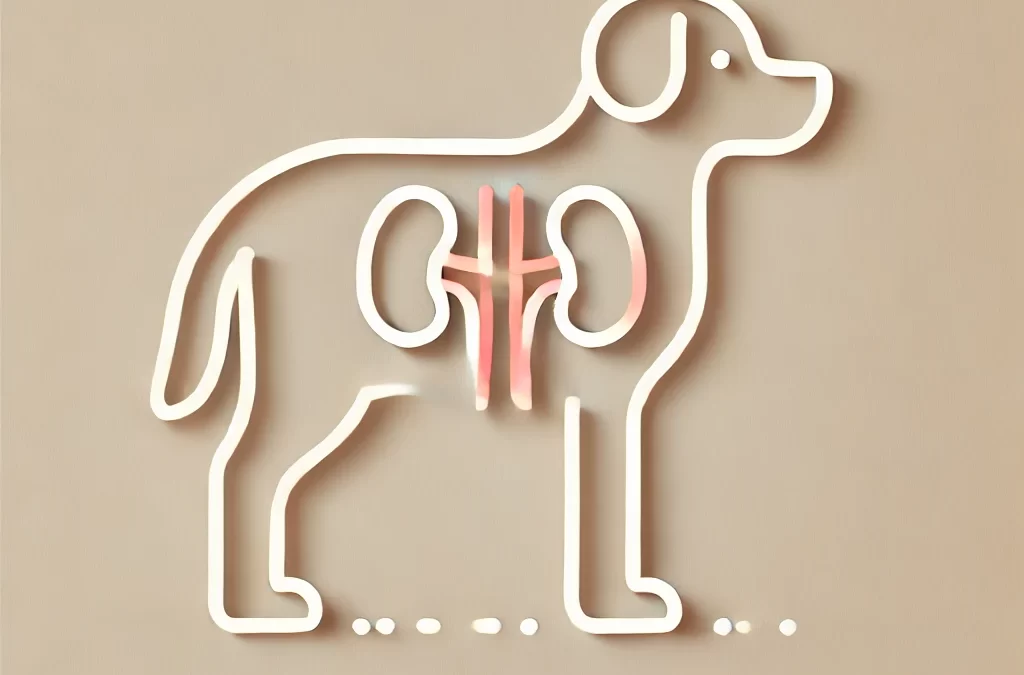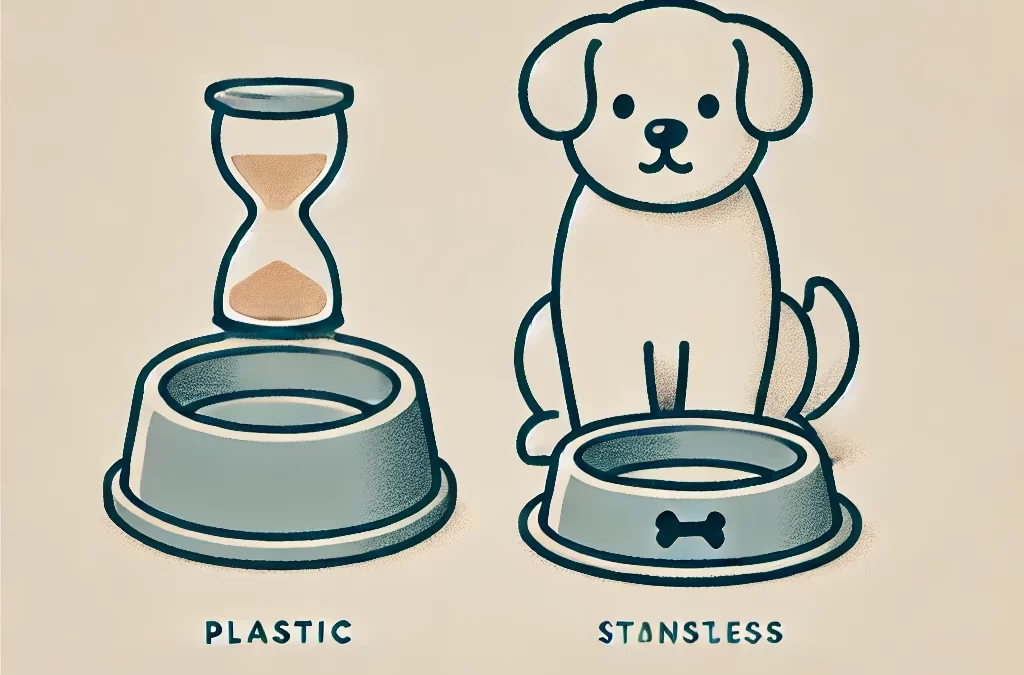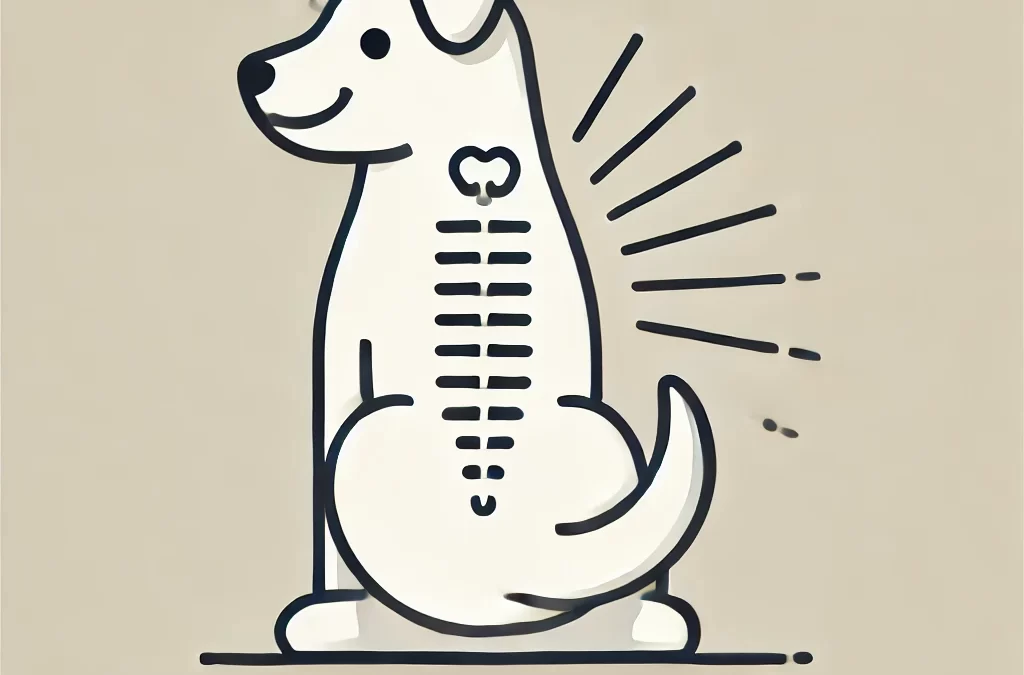
par TCMVET | 12 décembre 2024 | Cancer et tumeurs du chien
Le cancer du rein chez le chien est relativement rare, mais il peut avoir des conséquences importantes sur la santé de l'animal lorsqu'il survient. Les symptômes apparaissent souvent progressivement, ce qui rend la détection précoce difficile. La connaissance des signes potentiels peut aider les propriétaires d'animaux à rechercher des soins vétérinaires en temps opportun.
Symptômes courants du cancer du rein chez le chien
- Augmentation de la soif et de la miction (polydipsie et polyurie) :
- Une consommation excessive d’alcool et une miction excessive peuvent indiquer une altération de la fonction rénale due à la tumeur.
- Loss of Appetite:
- Les chiens atteints d’un cancer du rein connaissent souvent une diminution de l’appétit, entraînant une perte de poids.
- Weight Loss:
- Même avec une alimentation normale, une perte de poids peut survenir car le corps dépense de l’énergie pour combattre la maladie.
- Vomissements et nausées :
- Le dysfonctionnement rénal causé par le cancer peut entraîner une accumulation de toxines dans le sang, provoquant des problèmes gastro-intestinaux.
- Douleur ou gonflement abdominal :
- Les tumeurs peuvent provoquer un gonflement visible ou une gêne lorsque l’abdomen est touché.
- Sang dans les urines (hématurie) :
- L’urine peut paraître rose ou rouge en raison du saignement de la tumeur.
- Lethargy:
- Les chiens atteints d’un cancer du rein peuvent présenter des niveaux d’énergie réduits et une réticence à s’engager dans des activités normales.
- Difficulty Breathing:
- Dans les cas avancés, les tumeurs peuvent exercer une pression sur les organes environnants, provoquant des problèmes respiratoires.
- Gencives pâles :
- L’anémie, souvent associée au cancer du rein, peut provoquer une pâleur des gencives.
- Mauvaise haleine (haleine urémique) :
- Une accumulation de toxines dans le sang due à une fonction rénale réduite peut entraîner une odeur semblable à celle de l’ammoniac.
Quand consulter un vétérinaire
Si votre chien présente une combinaison de ces symptômes, il est essentiel de consulter rapidement un vétérinaire. Bien que ces signes ne soient pas exclusifs au cancer du rein, ils indiquent souvent un problème de santé sous-jacent grave qui nécessite un diagnostic et un traitement.
Diagnostic du cancer du rein chez le chien
Un vétérinaire utilisera généralement les méthodes suivantes pour confirmer le cancer du rein :
- Examen physique : Pour détecter un gonflement ou un inconfort.
- Analyse d'urine : Pour vérifier la présence de sang ou de substances anormales dans l’urine.
- Des analyses de sang: Pour évaluer la fonction rénale et détecter d’éventuelles anomalies.
- Imagerie : L’échographie, les rayons X ou la tomodensitométrie peuvent identifier les tumeurs et leur étendue.
- Biopsie: Un échantillon de la tumeur peut être prélevé pour confirmer sa nature.
Traitement et pronostic
Les options de traitement dépendent du type et du stade de la tumeur, mais peuvent inclure :
- Chirurgie : Ablation du rein affecté (néphrectomie) si le cancer est localisé.
- Chimiothérapie : Pour certains types de cancer, la chimiothérapie peut ralentir la progression.
- Soins de soutien : Gestion de la douleur, hydratation et soutien nutritionnel pour maintenir la qualité de vie.
La détection précoce améliore les résultats du traitement. Des contrôles vétérinaires réguliers sont donc essentiels, en particulier pour les chiens âgés.
En reconnaissant ces symptômes et en agissant rapidement, vous pouvez offrir à votre chien les meilleures chances de recevoir des soins efficaces et de maintenir une bonne qualité de vie.

par TCMVET | 11 décembre 2024 | Cancer et tumeurs du chien
Le plastique est omniprésent dans notre vie quotidienne, des contenants alimentaires aux articles ménagers, et même dans les produits conçus pour nos amis à quatre pattes. Mais ce matériau apparemment inoffensif pourrait-il constituer une menace pour la santé de nos chiens ? De nouvelles études suggèrent qu'une exposition prolongée à certains types de plastique pourrait augmenter le risque de cancer chez les chiens. Examinons les résultats scientifiques et les mesures que les propriétaires d'animaux peuvent prendre pour protéger leurs animaux.
Les dangers cachés du plastique
De nombreux types de plastiques contiennent des produits chimiques nocifs tels que le bisphénol A (BPA), les phtalates et le chlorure de polyvinyle (PVC). Ces produits chimiques sont souvent utilisés pour rendre le plastique durable, flexible ou transparent. Cependant, ils peuvent s'infiltrer dans les aliments, l'eau ou même l'environnement, en particulier lorsque les plastiques sont chauffés, rayés ou dégradés.
Chez les animaux, ces produits chimiques peuvent agir comme des perturbateurs endocriniens, interférant avec la fonction hormonale. Une exposition prolongée peut entraîner des changements cellulaires, un stress oxydatif et même la formation de tumeurs, augmentant ainsi le risque de cancer. Pour les chiens, dont les habitudes quotidiennes incluent souvent le fait de mâcher, de lécher et d'être en contact étroit avec divers matériaux, les risques sont aggravés.
Sources quotidiennes d'exposition au plastique pour les chiens
- Bols pour la nourriture et l'eau:De nombreux propriétaires de chiens utilisent sans le savoir des bols en plastique, qui peuvent libérer des substances nocives, surtout s'ils sont rayés ou exposés au soleil.
- Jouets à mâcher:Les jouets en plastique de mauvaise qualité contiennent souvent des matériaux non réglementés qui peuvent présenter un risque s’ils sont ingérés ou mâchés de manière excessive.
- Conditionnement:Les friandises, croquettes et autres produits pour chiens sont souvent stockés dans des emballages en plastique, ce qui peut laisser pénétrer des produits chimiques dans les aliments.
- Articles ménagers:Les chiens entrent fréquemment en contact avec des objets en plastique dans la maison, des contenants aux meubles.
Risques de cancer liés au plastique
Bien que les liens directs entre l’exposition au plastique et le cancer chez les chiens soient encore à l’étude, des preuves issues de recherches sur les humains et les animaux indiquent une relation inquiétante. Chez les chiens, les cancers tels que les tumeurs mammaires, le cancer des testicules et le lymphome peuvent être influencés par des toxines environnementales, notamment celles présentes dans le plastique. Les races de petite taille ou les chiens souffrant de problèmes de santé préexistants peuvent être particulièrement vulnérables.
Mesures pour réduire l’exposition au plastique
Les propriétaires d’animaux de compagnie peuvent prendre des mesures proactives pour minimiser l’exposition de leur chien aux plastiques nocifs :
- Passez à des bols plus sûrs:Utilisez des bols en acier inoxydable, en céramique ou en verre pour la nourriture et l’eau plutôt que des bols en plastique.
- Choisissez des jouets de haute qualité:Optez pour des jouets non toxiques, sans BPA ou fabriqués à partir de matériaux naturels comme le caoutchouc.
- Repenser le stockage:Conservez les aliments et les friandises pour chiens dans des contenants hermétiques en verre ou en acier inoxydable plutôt que de les laisser dans leur emballage en plastique d’origine.
- Inspectez votre maison:Limitez l’accès de votre chien aux objets en plastique de mauvaise qualité qui pourraient être mâchés ou ingérés.
- Évitez de chauffer les plastiques:Ne mettez jamais d’aliments ou de friandises au micro-ondes dans des récipients en plastique, car la chaleur augmente la lixiviation des produits chimiques.
Plaidoyer pour des normes plus sûres
Au-delà des choix personnels, les propriétaires d’animaux peuvent plaider en faveur de meilleures normes de sécurité dans le secteur des produits pour animaux de compagnie. Soutenir les marques qui privilégient les matériaux non toxiques et les pratiques durables envoie un message puissant. De plus, rester informé des rappels de produits ou des recherches émergentes peut aider à protéger votre chien des risques cachés.
La vue d’ensemble
Bien que le plastique soit omniprésent dans la vie moderne, ses effets potentiels sur la santé ne peuvent être ignorés. Pour nos chiens, réduire l’exposition aux plastiques nocifs est un moyen simple mais efficace de soutenir leur santé et leur bien-être à long terme. En faisant des choix conscients et en sensibilisant les gens, nous pouvons faire en sorte que nos animaux de compagnie vivent une vie plus heureuse et plus saine.

par TCMVET | 11 décembre 2024 | Cancer et tumeurs du chien
En ce qui concerne les chiens, la taille a son importance, mais pas seulement de la manière dont on le pense habituellement. Alors que les grands chiens sont admirés pour leur force et les petits pour leur charme, des études récentes ont révélé un lien surprenant entre la taille d'un chien et son risque de développer un cancer. Plongeons-nous dans ce lien intriguant et découvrons ce qu'il signifie pour les propriétaires d'animaux de compagnie.
La science derrière la taille et le risque de cancer
Des études ont montré que les grandes races, comme les Dogues allemands, les Bouviers bernois et les Rottweilers, sont plus sujettes à certains cancers que leurs homologues plus petits. Mais pourquoi ? La réponse se trouve dans la biologie. Les grands chiens grandissent plus vite et ont plus de cellules dans leur corps. Cette activité cellulaire accrue augmente les risques de mutations, qui peuvent conduire au cancer.
En revanche, les petites races comme les chihuahuas et les teckels ont tendance à avoir un risque de cancer plus faible, mais ne sont pas complètement immunisées. Certains cancers, comme les tumeurs des mastocytes, peuvent néanmoins toucher les chiens de petite taille, souvent en raison de prédispositions génétiques plutôt que de la taille.
Croissance rapide : une arme à double tranchant
Les grandes races connaissent des poussées de croissance rapides pendant leur enfance, ce qui met leur corps à rude épreuve. Cette croissance rapide peut entraîner une division cellulaire moins stable, ce qui augmente le risque de comportement cellulaire anormal au fil du temps. De plus, les exigences métaboliques des chiens de grande taille peuvent accélérer le vieillissement, les rendant plus vulnérables aux maladies, notamment au cancer, à mesure qu'ils vieillissent.
Longévité et risque de cancer
Les petits chiens vivent souvent beaucoup plus longtemps que les grandes races. Si cette longévité donne aux petits chiens plus de temps pour développer des maladies liées à l’âge, elle signifie également que leur croissance et leur renouvellement cellulaire plus lents peuvent les protéger des cancers à apparition précoce, généralement observés chez les grandes races. En revanche, la durée de vie plus courte des grands chiens est souvent corrélée à une prévalence plus élevée de cancers agressifs à un plus jeune âge.
Ce que les propriétaires d’animaux peuvent faire
Les propriétaires d'animaux peuvent prendre des mesures proactives pour minimiser les risques de cancer, quelle que soit la taille de leur chien. Des contrôles vétérinaires réguliers, une alimentation équilibrée et des routines d'exercice appropriées sont essentiels. Pour les grandes races, une attention particulière doit être accordée au maintien d'un poids santé, car l'obésité peut aggraver les risques de cancer. Les petits chiens, bien que moins sujets aux cancers liés à la taille, bénéficient toujours de dépistages génétiques pour identifier les risques héréditaires à un stade précoce.
Redéfinir « La taille compte »
Le lien entre la taille et le risque de cancer nous pousse à repenser notre approche des soins aux chiens. Bien que nous ne puissions pas modifier la taille d'un chien, comprendre comment elle influence sa santé peut nous aider à prendre des décisions éclairées. Du choix des races à l'adaptation des routines de soins, ces connaissances permettent aux propriétaires d'animaux de compagnie de donner à leurs amis à quatre pattes les meilleures chances de vivre une vie longue et saine.
En fin de compte, qu’il soit grand ou petit, chaque chien mérite de l’amour, de l’attention et des soins de santé proactifs. En restant informés, nous pouvons tous jouer un rôle dans la réduction des risques de cancer et assurer le bien-être de nos compagnons canins.

par TCMVET | 9 décembre 2024 | Cancer et tumeurs du chien
Les tumeurs de la colonne vertébrale chez les chiens, bien que rares, peuvent avoir de graves répercussions sur leur mobilité et leur qualité de vie. Ces tumeurs peuvent se développer à l'intérieur ou autour de la colonne vertébrale, affectant le fonctionnement du système nerveux. Une détection précoce et une gestion appropriée sont essentielles pour fournir les meilleurs soins à votre ami à quatre pattes. Voici un guide complet sur les types de tumeurs de la colonne vertébrale chez les chiens et leurs symptômes, causes et options de traitement.
Types courants de tumeurs de la colonne vertébrale chez le chien
- Tumeurs intramédullaires
- Description: Ces tumeurs se développent dans la moelle épinière elle-même. Elles proviennent souvent des cellules gliales, qui soutiennent le système nerveux.
- Exemples : Astrocytomes, épendymomes et oligodendrogliomes
- Symptômes: Faiblesse progressive, incoordination et possible paralysie dans les cas graves
- Traitement : Chirurgie (si possible), radiothérapie et soins de soutien
- Tumeurs extradurales
- Description: Ces tumeurs se produisent à l’extérieur de la moelle épinière mais à l’intérieur du canal rachidien, comprimant souvent la moelle et provoquant des problèmes neurologiques.
- Exemples : Ostéosarcomes, fibrosarcomes et lymphomes
- Symptômes: Maux de dos, difficulté à marcher et faiblesse musculaire
- Traitement : Ablation chirurgicale, chimiothérapie ou radiothérapie, selon le type de tumeur
- Tumeurs intradurales-extramédullaires
- Description: Situées dans le canal rachidien mais à l’extérieur de la moelle épinière, ces tumeurs se développent dans les méninges ou les racines nerveuses environnantes.
- Exemples : Méningiomes, tumeurs des gaines nerveuses (schwannomes)
- Symptômes: Douleur, incoordination et possible incontinence urinaire ou intestinale
- Traitement : Chirurgie et radiothérapie
- Tumeurs vertébrales
- Description: Ces tumeurs proviennent des os de la colonne vertébrale, provoquant une instabilité structurelle et une compression potentielle de la moelle épinière.
- Exemples : Ostéosarcome, chondrosarcome
- Symptômes: Douleur intense, gonflement et difficulté à se tenir debout ou à marcher
- Traitement : Chirurgie, chimiothérapie et gestion de la douleur
Symptoms of Spinal Tumors in Dogs
Les symptômes des tumeurs de la colonne vertébrale peuvent varier en fonction de l’emplacement et de la taille de la tumeur, mais les signes courants incluent :
- Réticence à bouger ou à jouer
- Difficulté à marcher ou à traîner les membres
- Douleur ou sensibilité dans le dos ou le cou
- Perte de contrôle de la vessie ou des intestins
- Changements soudains de comportement ou de posture
Causes et facteurs de risque
Les tumeurs de la colonne vertébrale chez les chiens peuvent être causées par :
- Prédisposition génétique: Certaines races comme les bergers allemands et les golden retrievers peuvent être plus à risque.
- Age: Les chiens plus âgés sont plus susceptibles de développer des tumeurs de la colonne vertébrale.
- Métastase cancéreuse : Des tumeurs provenant d’autres parties du corps peuvent se propager à la colonne vertébrale.
Diagnostic et traitement
Les vétérinaires utilisent plusieurs méthodes pour diagnostiquer les tumeurs de la colonne vertébrale :
- Examen neurologique : Évalue les réflexes, la coordination et la réponse à la douleur.
- Imagerie : Radiographies, IRM ou tomodensitométrie pour localiser et évaluer la tumeur.
- Biopsie: Confirme le type de tumeur pour un traitement ciblé.
Les options de traitement comprennent :
- Chirurgie : La méthode privilégiée pour les tumeurs accessibles et opérables.
- Radiothérapie : Utilisé pour les tumeurs inopérables ou résiduelles après une intervention chirurgicale.
- Chimiothérapie : Efficace pour certaines tumeurs métastatiques ou primaires de la colonne vertébrale.
- Prise en charge de la douleur : Indispensable pour améliorer la qualité de vie du chien.
Accompagner votre chien pendant sa convalescence
Les soins pour les chiens atteints de tumeurs de la colonne vertébrale doivent inclure :
- Fournir un lit moelleux et de soutien pour éviter les escarres
- Aide à la mobilité grâce à des harnais ou des chariots
- Maintenir une alimentation nutritive pour soutenir la santé globale
- Des suivis réguliers avec le vétérinaire pour surveiller les progrès
Conclusion
Les tumeurs de la colonne vertébrale chez les chiens nécessitent une attention immédiate et des soins spécialisés. Bien que le pronostic dépende du type de tumeur et de sa progression, les progrès de la médecine vétérinaire ont rendu les traitements plus efficaces. En comprenant les symptômes et les options disponibles, vous pouvez vous assurer que votre chien reçoit les meilleurs soins et le meilleur soutien.

par TCMVET | 9 décembre 2024 | Cancer et tumeurs du chien
La santé de la peau des chiens est souvent le reflet de leur bien-être général, mais certaines affections peuvent être déroutantes, même pour les propriétaires d'animaux les plus attentifs. L'une de ces affections rares est épithéliomes cornifiés, un type de tumeur cutanée bénigne qui peut susciter des inquiétudes en raison de son apparence et de ses effets. Examinons de plus près cette affection dermatologique inhabituelle, ses causes, ses traitements et ce qui en fait un défi unique dans les soins de santé canins.
Que sont les épithéliomes cornifiants ?
Les épithéliomes cornéens sont des tumeurs bénignes qui proviennent des glandes sébacées, plus précisément de l'épithélium (cellules cutanées) responsable de la production de kératine. Ces tumeurs se présentent souvent sous forme de nodules ressemblant à des verrues sur la peau d'un chien. Bien qu'elles ne mettent pas la vie en danger, leur potentiel de gêne ou d'infection signifie qu'elles ne doivent pas être ignorées.
Quelles sont les causes des épithéliomes cornifiés ?
La cause exacte des épithéliomes kératinisés n’est pas entièrement comprise, mais les facteurs contributifs peuvent inclure :
- Prédisposition génétique: Les races telles que les cockers, les beagles et les huskies de Sibérie sont plus susceptibles de développer ces excroissances.
- Déséquilibres hormonaux : L’activité des glandes sébacées peut être influencée par les changements hormonaux, en particulier chez les chiens âgés.
- Carences alimentaires : Une mauvaise nutrition peut entraîner des déséquilibres dans la santé de la peau, aggravant potentiellement des affections comme les épithéliomes.
Reconnaître les symptômes
Les épithéliomes kératinisés apparaissent généralement comme :
- Nodules petits et fermes avec une texture semblable à celle d'une verrue
- Couleur jaunâtre ou cireuse en raison de l'accumulation de kératine
- Localisée autour de la tête, du cou ou du dos, mais peut survenir n'importe où
- Parfois accompagnée de rougeur ou d'inflammation en cas d'infection secondaire
Bien que ces excroissances soient bénignes, des changements rapides de taille, de couleur ou de texture doivent être évalués par un vétérinaire pour exclure des tumeurs malignes.
Diagnostic des épithéliomes cornifiés
Le diagnostic implique généralement :
- Examen physique : Un vétérinaire évaluera la taille, l’emplacement et l’apparence des excroissances.
- Aspiration à l'aiguille fine (AAF) : Un échantillon de cellules est extrait et analysé pour confirmer la nature de la tumeur.
- Biopsie: Dans certains cas, une biopsie peut être nécessaire pour différencier les épithéliomes bénins d’autres affections cutanées ou cancers.
Options de traitement
Le traitement dépend de la gravité et de l’impact des épithéliomes sur la qualité de vie de votre chien.
- Contrôle
Pour les petites excroissances non problématiques, une surveillance régulière est souvent suffisante.
- Assurez-vous que la zone reste propre et exempte d’infection.
- Utilisez des traitements topiques apaisants si recommandés par votre vétérinaire.
- Retrait chirurgical
Si les excroissances provoquent une gêne, des infections récurrentes ou des problèmes esthétiques, l’ablation chirurgicale est une solution courante.
- Les techniques mini-invasives comme la chirurgie au laser peuvent réduire le temps de récupération.
- Thérapies topiques ou systémiques
- Les rétinoïdes ou suppléments de vitamine A peuvent réguler la production de kératine.
- Des antibiotiques peuvent être prescrits en cas d’infections bactériennes secondaires.
Des approches innovantes et naturelles
Pour les propriétaires souhaitant compléter les traitements conventionnels par des soins holistiques :
- Les acides gras omega-3: Ils peuvent réduire l’inflammation et favoriser la santé globale de la peau.
- Remèdes à base de plantes: Le calendula et l’aloe vera peuvent apaiser les zones irritées.
- Ajustements alimentaires : Une alimentation riche en antioxydants et en protéines de haute qualité favorise la régénération de la peau.
Mesures préventives
Bien que tous les cas d’épithéliomes cornifiés ne puissent pas être évités, les étapes suivantes peuvent aider à maintenir une santé cutanée optimale :
- Toilettage régulier : Maintient la peau propre et favorise la détection précoce des anomalies.
- Régime équilibré: Soutient le système immunitaire et réduit le risque de problèmes de peau.
- Visites vétérinaires de routine : Une intervention précoce est essentielle pour gérer toute affection cutanée.
Un défi unique en dermatologie canine
Les épithéliomes cornifiés soulignent l'importance de comprendre et de traiter même les maladies rares chez les chiens. Bien que bénignes, ces excroissances peuvent avoir un impact sur le confort et l'apparence de votre animal, ce qui rend essentielle une gestion rapide et efficace. En restant informé et en travaillant en étroite collaboration avec votre vétérinaire, vous pouvez vous assurer que votre chien reste en bonne santé, heureux et prospère.





